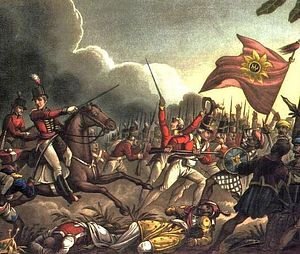On June 18, 2015, Britain will celebrate the 200th anniversary of the Battle of Waterloo. There, southeast of Brussels, on the gentle slopes of Mont St Jean, 170,000 soldiers fought furiously to decide the fate of Europe for the next hundred years. Napoleon’s return from Elba had threatened to again upset the balance of power on the continent, but at Waterloo he suffered his final defeat at the hands of armies led by Sir Arthur Wellesley, the Duke of Wellington.
Wellington described the Battle of Waterloo as “the most desperate business I was ever in . . .” and “the nearest run thing you ever saw in your life.” At several crucial moments during the battle, Wellington’s generalship was decisive. His Horse Artillery commander Sir Alexander Frazer described Wellington as “[c]old and indifferent . . . in the beginning of battles, when the moment of difficulty comes intelligence flashes from the eyes of this wonderful man; and he rises superior to all that can be imagined.”
Before Waterloo, Wellington had brilliantly commanded armies on the Iberian Peninsula, where they wore down and drained French forces, causing Napoleon to refer to it as “the Spanish ulcer.” But Wellington learned how to command, supply, and lead soldiers to victory not in Europe, where he is most remembered, but in India. Wellington in India, wrote biographer Elizabeth Longford, was “a great commander in embryo.”
Wellington, then Colonel Arthur Wesley (the last name was later changed to Wellesley) of the 33rd regiment, arrived in Calcutta at the age of 28 in February 1797, after a journey of more than three months. His most recent biographer, Rory Muir, described Colonel Wesley as “an unusually ambitious, intelligent and well-read officer who looked far beyond the horizons of his regiment . . . and who was already comfortable assembling his thoughts into coherent arguments . . .” In all, he spent eight years in India, where for much of the time his brother was Governor-General. Wellington’s time in India, writes Muir, “were crucial years in which he developed his skills as a commander of men, a tactician, a strategic planner and a civil governor.” It was in India that the future victor of Waterloo and future prime minister of Great Britain first dealt with questions of war and peace and civil government.
On March 26, 1799, troops under Wellington’s command came under attack by forces of Muslim ruler Tipu Sultan, the Tiger of Mysore. As the French-trained enemy forces approached, wrote Elizabeth Longford, Wellington’s men held their fire “with the utmost steadiness until the enemy were sixty yards away.” British infantry then decimated the columns of enemy attackers, spreading confusion, while cavalry forces scattered the remnants of the attacking force. Then, during April and May 1799, Wellington participated in the siege of Seringapatam in Mysore, and led an attack on the entrenchments of the fortress there.After Seringapatam was taken, Wellington was made civil governor and remained there until 1802.
During his time in Seringapatam, Wellington was ordered to suppress a rebellion in north Mysore led by Dhoondiah Waugh. For the first time, Wellington exercised independent command in battle. During this operation, Rory Muir explains, Wellington “displayed all the characteristics of his subsequent campaigns, . . .” which included attention to logistics and “unremitting aggression.” He fought a battle at Conaghul and won a complete victory. Muir writes that Wellington exhibited a remarkable flexibility on the field of battle. A British officer commented on Wellington’s “alacrity and determination” during battle.
On September 23, 1803, Wellington, now a Major General, won his first major victory at the Battle of Assaye. His forces were outnumbered twenty to one by troops of the Maratha Confederacy. After receiving word from a cavalry patrol that the enemy’s forces were nearby, Wellington advanced and to high ground and saw the enemy encampment. Despite being outnumbered, Wellington attacked almost at once, catching enemy forces by surprise. Muir writes that he concentrated his forces “to attack the key part of the enemy’s army, while protecting his flanks and rear . . .” He achieved a decisive victory at Assaye but, like Waterloo, at a frightful cost. The battle was won, wrote Elizabeth Longford, “in rivers of blood.” Wellington later remarked that Battle of Assaye was “the bloodiest for the numbers that I ever saw.” One officer noted that Wellington “was in the thick of the action the whole time . . . I never saw a man so cool and collected as he was.” Another officer commented that Wellington “behaved with perfect indifference in the hottest fire.”
Many years later, Longford wrote, when a friend asked Wellington what was the best thing he ever did in the way of fighting, the Duke somberly replied: “Assaye.”
All of the characteristics of generalship that earned Wellington great fame on the Peninsula and at Waterloo were on display in India. The victory at Waterloo two hundred years ago owes much to Wellington’s baptism by fire at Mysore and Assaye.

































